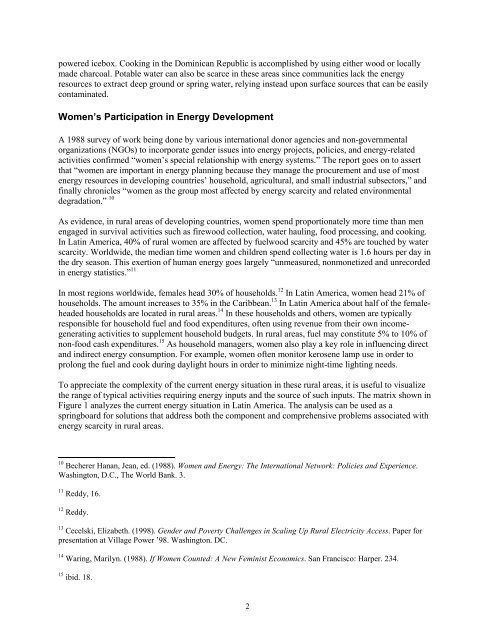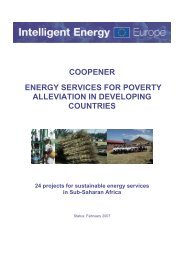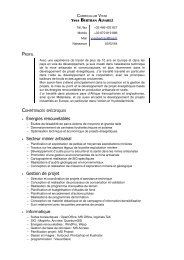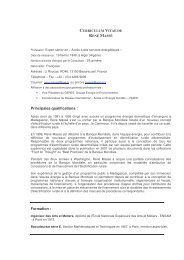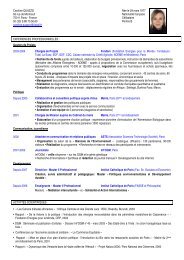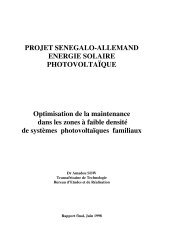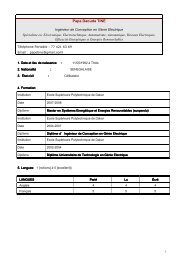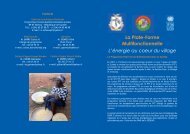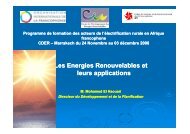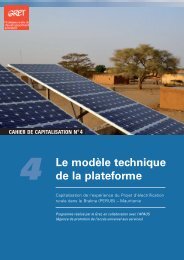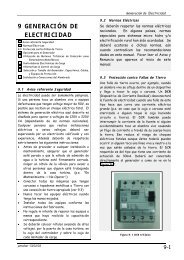powered icebox. Cooking in the Dominican Republic is accomplished by using either wood or locallymade charcoal. Potable water can also be scarce in these areas since communities lack the energyresources to extract deep ground or spring water, relying instead upon surface sources that can be easilycontaminated.Women’s Participation in Energy DevelopmentA 1988 survey of work being done by various international donor agencies <strong>and</strong> non-governmentalorganizations (NGOs) to incorporate gender issues into energy projects, policies, <strong>and</strong> energy-relatedactivities confirmed “women’s special relationship with energy systems.” The report goes on to assertthat “women are important in energy planning because they manage the procurement <strong>and</strong> use of mostenergy resources in developing countries’ household, agricultural, <strong>and</strong> small industrial subsectors,” <strong>and</strong>finally chronicles “women as the group most affected by energy scarcity <strong>and</strong> related environmentaldegradation.” 10As evidence, in rural areas of developing countries, women spend proportionately more time than menengaged in survival activities such as firewood collection, water hauling, food processing, <strong>and</strong> cooking.In Latin America, 40% of rural women are affected by fuelwood scarcity <strong>and</strong> 45% are touched by waterscarcity. Worldwide, the median time women <strong>and</strong> children spend collecting water is 1.6 hours per day inthe dry season. This exertion of human energy goes largely “unmeasured, nonmonetized <strong>and</strong> unrecordedin energy statistics.” 11In most regions worldwide, females head 30% of households. 12 In Latin America, women head 21% ofhouseholds. The amount increases to 35% in the Caribbean. 13 In Latin America about half of the femaleheadedhouseholds are located in rural areas. 14 In these households <strong>and</strong> others, women are typicallyresponsible for household fuel <strong>and</strong> food expenditures, often using revenue from their own incomegeneratingactivities to supplement household budgets. In rural areas, fuel may constitute 5% to 10% ofnon-food cash expenditures. 15 As household managers, women also play a key role in influencing direct<strong>and</strong> indirect energy consumption. For example, women often monitor kerosene lamp use in order toprolong the fuel <strong>and</strong> cook during daylight hours in order to minimize night-time lighting needs.To appreciate the complexity of the current energy situation in these rural areas, it is useful to visualizethe range of typical activities requiring energy inputs <strong>and</strong> the source of such inputs. The matrix shown inFigure 1 analyzes the current energy situation in Latin America. The analysis can be used as aspringboard for solutions that address both the component <strong>and</strong> comprehensive problems associated withenergy scarcity in rural areas.10 Becherer Hanan, Jean, ed. (1988). Women <strong>and</strong> Energy: The International Network: Policies <strong>and</strong> Experience.Washington, D.C., The World Bank. 3.11 Reddy, 16.12 Reddy.13 Cecelski, Elizabeth. (1998). Gender <strong>and</strong> Poverty Challenges in Scaling Up <strong>Rural</strong> Electricity Access. Paper forpresentation at Village Power ’98. Washington. DC.14 Waring, Marilyn. (1988). If Women Counted: A New Feminist Economics. San Francisco: Harper. 234.15 ibid. 18.2
Figure 1 illustrates how the energy inputs for daily household activities are heavily dependent on humanenergy <strong>and</strong> on polluting fuels. In addition, many activities considered vital to an improved quality of life –such as refrigeration, are simply not feasible in unelectrified rural areas.Since women are disproportionately responsible for household tasks, they, together with children, sufferhigh incidences of health-related problems associated with the use of traditional fuels for energy needs.For example, the open fire commonly used in Latin America for cooking in poorly ventilated indoorkitchens exposes women to high amounts of particulate pollution causing respiratory infections inchildren <strong>and</strong> chronic lung disease in non-smoking women. Indirectly, scarce fuel for proper cooking <strong>and</strong>water boiling can lead to malnutrition, diarrhea, <strong>and</strong> parasites. Safety is also a factor. Use of kerosenelighting has also been known to cause fires or burns, while women may search for firewood or water indangerous locations <strong>and</strong>/or gather oversized wood or water loads. 16Energy issues can tend to get lost in the portfolio of development activities concentrating on urgent “basicneeds.” However, when the link between energy <strong>and</strong> basic needs like food <strong>and</strong> health can be made,energy becomes a complementary activity necessary to help women meet minimum quality of life levels.Several organizations, including Winrock International, Habitat for Humanity <strong>and</strong> Plan International,have made this link. As a result, international development organizations are paying greater attention toenergy impacts, especially at the household level. Energy for cooking is a good example of this. Today,numerous indigenous <strong>and</strong> international groups are introducing alternative stove technologies, includingceramic, lorena (clay) <strong>and</strong> solar stoves. 17To illustrate how energy <strong>and</strong> basic human needs relate, consider the hierarchy of needs developed by thepsychologist Abraham Maslow. Maslow argues that human needs can be arranged into categories orderedfrom the most to least pressing. At the base of they hierarchical pyramid are physiological needs, onwhich safety, social, esteem needs are built with self-actualization needs filling the pinnacle of thepyramid. Energy for clean water <strong>and</strong> lighting plays a role in helping people achieve the fundamentalphysiological <strong>and</strong> safety needs that are essential for one to ascend into fulfilling the psychological needsthat enhance life. As such, development projects should view energy issues as an integral component ofsatisfying the range of human development needs. For example, it is well documented that education <strong>and</strong>income generation, two things that can be significantly enhanced with energy, can contribute to thesustainable fulfillment of basic needs, as well as the social <strong>and</strong> esteem needs associated individual <strong>and</strong>societal advancement.The information in Figure 1 implies that community enhancement activities (such as education, healthcare, <strong>and</strong> religious gatherings) depend on day light hours or the use of kerosene lamps for nighttime use.In some cases, especially in the Dominican Republic, electric generators may be purchased or rotated tofulfill needs, although it is more common for these activities to remain in urban areas where energyresources allow for fuller utilization of facilities <strong>and</strong> equipment. As a result, rural populations are deniedaccess to key services considered routine to their urban counterparts. The lack of these services, combinedwith limited opportunity for income-generation activities, is an oft-cited motivation for urban migration.Often men migrate to urban areas, either on a temporary or permanent basis, seeking opportunities that donot exist in rural areas, leaving women behind to cope with increased domestic <strong>and</strong> economicresponsibilities.16 Reddy. 38.17 International organizations working in this area include <strong>Solar</strong> Cookers International, World Vision <strong>and</strong>Appropriate Technology International. Local organizations include ADEPE <strong>and</strong> FUDECO in the DominicanRepublic <strong>and</strong> Proleña in Honduras.3


